If there’s one Spanish institution that needs absolutely no introduction, it’s Flamenco. Perhaps paella, bullfighting, tapas or Rioja wine would yield higher scores in a round of Family Fortunes when attempting to guess Spain’s most immediate subtexts, but Flamenco would certainly be in there somewhere.
What is Flamenco?
It is considered less a genre of music and more an artform in southern Spain. A typical Flamenco performance is made up of four elements: cante (singing), toque (guitar playing), baile (dancing) and jaleo (vocalisations and rhythmic clapping). The structure of each song is usually determined by its palo – the specific Flamenco style, according to rhythm and geographical origin among other criteria. Some palos are sung without a guitar; others are danced while others aren’t. However, both Flamenco artists and enthusiasts would probably argue that the key components to any Flamenco recital are spontaneity and individual interpretation of the performers.
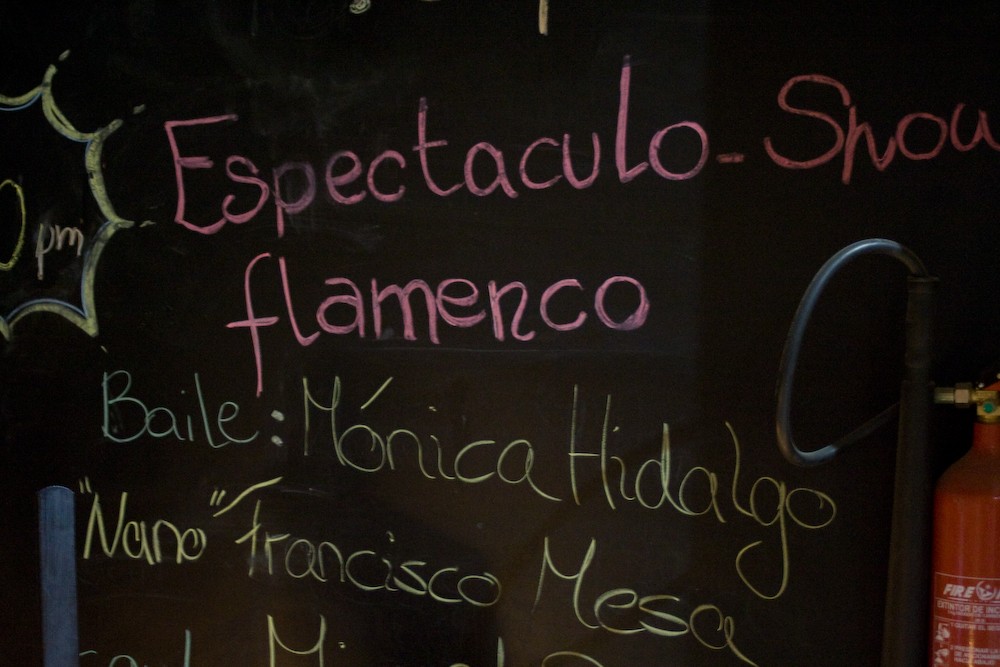
Espectaculo Flamenco (Source: FlickrCC travelho)
Origin, Transcendence & Meaning
Flamenco, as it’s known today, goes back at least 200 years, shaping the cultural perspective of many a Spaniard along the way. However, it isn’t necessarily as central to the lives of ‘Spaniards’, on a national scale, as, say, the pub is among the British. Only in the southern regions of Andalucia, Extremadura and Murcia is Flamenco sometimes considered the holy grail of music and dance.
It’s this undying and moderately provincial passion that characterises Flamenco down to its core. From its 18th century roots in gitano pueblos through to modern day arena-sized performances, the enthusiasm for practicing and watching Flamenco has always remained as fierce. You only have to wander into a busy Flamenco bar to observe its significance and steely staying power. Children, parents, grandparents and great grandparents crowd around the small ensembles and will strain their necks to watch the magic unfold.
Flamenco Shows & Peñas
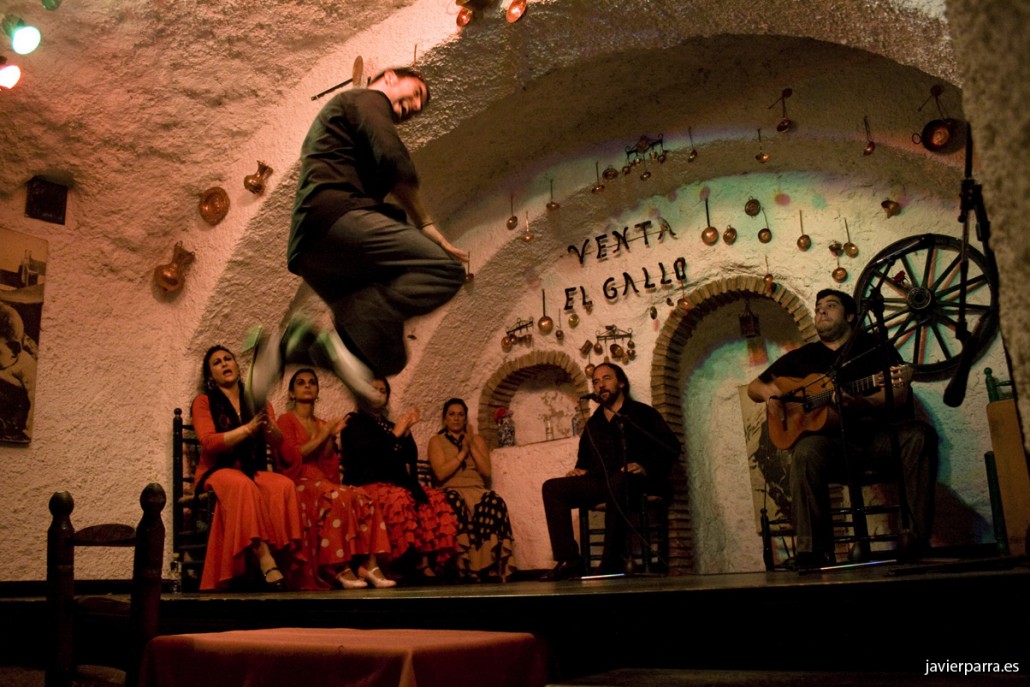
Flamenco at Venta El Gallo, Granada (Source: FlickrCC arteunporro)
There is ample opportunity to see Flamenco in Andalucia, but before you do it’s well worth understanding the difference between a Flamenco show and a peña.
Flamenco shows are often better-planned and promoted events and are thus more expensive to attend. They are quite spectacular and can generally be relied upon to see the best-known Flamenco artists. Locals, though, will likely tell you that the real Flamenco is to be found in the peñas.
To be in with a chance of seeing Flamenco at a peña, which roughly translates as a member’s club, you have to read the newspaper; look out for cheap flyers taped to lampposts; talk to locals; generally keep your eyes peeled and ears pricked in bars and cafés, as they are often impromptu in nature. Inside, the walls are bedecked with Flamenco photos, portraits and general memorabilia – it’s clear from the moment you walk in that the patrons live and breathe the music. Performers are not professional, rather people with regular day jobs with an insatiable passion for Flamenco. Generally speaking, anyone can play if they’d like – the principle is akin to a jamming session – though the standard of singing, dancing and guitar playing tends to be very high, despite the performers only being ‘amateur’.
Where to Go to see flamenco
People will pay large amounts of money and queue for unreasonably long periods of time to get a seat at a top Flamenco show or peña. However, in Andalucia, and particularly in major cities like Seville and Granada, you don’t usually have to try hard to find and get into an authentic Flamenco performance in a busy bar.
Unlike other live, acoustic music shows the audience are not required to remain completely silent as songs are played out; singing and clapping along is encouraged, as are cries of approval and encouragement, usually in the form of an ‘ole!’ or a ‘jale!’
Hundreds of shows and peñas take place across Andalucia every month, so it would, frankly, be near-impossible to list all (or even most) of them here. Instead we have picked out a few noteworthy examples of where to see Flamenco in Andalucia.
Jerez de la Frontera
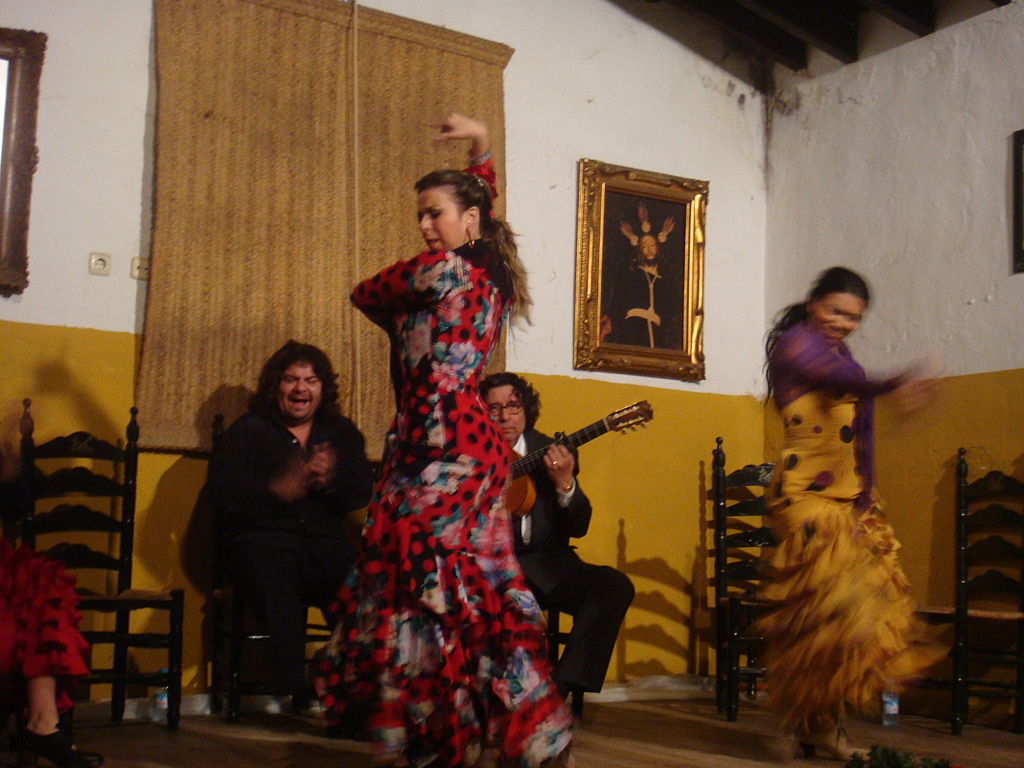
Flamenco in Jerez de la Frontera (Source: Wikimedia Commons: El Pantera)
Jerez is popularly regarded as la cuña – the birthplace – of Flamenco in Spain. It boasts the Andalucian Centre of Flamenco for a start, so there is probably a good chance that it all started there, and many of the most famous Flamenco artists come from Jerez, such as Lola Flores or José Mercé. In any case, Flamenco is to Jerez like cheese-rolling is to Gloucestershire. If passing through, and you’d like to catch a show or peña, head to:
Bars & Tablaos
Puro Arte, Tablao Flamenco (Flamenco every night. Reservation necessary.)
Details: Calle Conocedores, 28; Tel: +34 647 743 832; (puroarteflamencojerez.com)
Tabanco el Guitarrón de San Pedro (Flamenco Thursday night, Saturday afternoon, Sunday night.)
Details: Calle Bizcocheros, 16; Tel: +34 649 65 69 18; (Facebook Page)
Tablao del Bereber (Flamenco on Friday.)
Details: Calle de las Cabezas, 8-10; Tel: +34 605 94 75 77
Tabanco El Pasaje. (From Thursdays to Sunday.)
Details: Calle Sta. María, 8; Tel: 956 33 33 59; (tabancoelpasaje.com)
La Guarida del Angel
Details: Calle Porvenir, 1; Tel: +34 615 60 12 23; (Facebook Page)
Peñas
Peña Flamenca Los Cernícalos
Details: Calle de Sancho Vizcaíno, 25; Tel: +34 956 33 38 71; (flamencodejerez.com)
Peña Flamenca Buena Gente
Details: Calle Ánimas de San Lucas, 9; Tel: +34 956 33 84 04; (Facebook Page)
The Flamenco festival in Jerez is held during the last week of February and first week of March (Jerez.es). This is when the big names come out to play and the best classes are held. To attend a class, you must book in advance in September when tickets go on sale (yes, it’s that popular!)
Seville
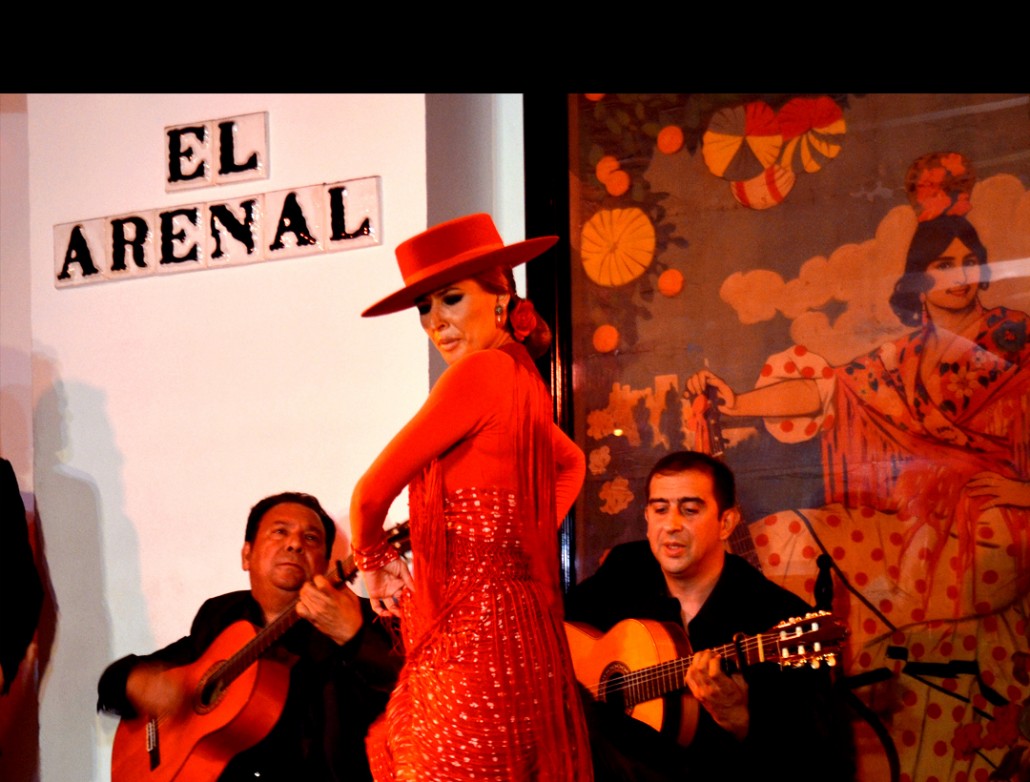
Flamenco at Tablao El Arenal, Sevilla
Since Seville is a much larger city than Jerez, there are, unsurprisingly, many more Flamenco bars and peñas to be found. However, Flamenco isn’t quite as popular as the livelier and crowd-galvanising Sevillanas, which dominates Seville’s renowned Feria in Spring.
Bars & Tablaos
Tablao Flamenco El Arenal (Flamenco every night. Reservation necessary.)
Details: Calle Rodo, 7; Tel: +34 954 216 492; (tablaoelarenal.com)
La Carbonería (Flamenco every night.)
Details: Calle Levíes, 18; Tel: +34 954 56 37 49
T de Triana (Flamenco on Tuesday, Thursday.)
Details: Calle Betis, 20; Tel: +34 95 43 31 203; (Facebook Page)
Casa de la Memoria (Flamenco every night. Reservation necessary.)
Details: Calle Cuna, 6; Tel: +34 954 560 670; (casadelamemoria.es)
Tablao Álvarez Quintero (Flamenco every night.)
Details: Calle Álvarez Quintero, 48; Tel: +34 605 13 01 30; (tablaoalvarezquintero.com)
Peñas
Torres Macarena (Flamenco on Wednesday night.)
Calle Torrijiano, 29; Tel: +34 954372384;
Niño de la Alfalfa (Flamenco Friday night.)
Details: Calle Castellar 52 Acc C; Tel: +34 619038562; (Facebook Page)
Amigos de Manuel Mairena (Flamenco Tuesday to Sunday.)
Details: Calle Guillén de Castro, 26; Tel: +34 686947804;
To be absolutely sure of catching a show, go in Autumn when the Peñas de Guardia take place, featuring talent young and old. If you go in Spring during Feria, the standard will be very high but many of the tents with best shows are often ‘guest list only’.
Granada
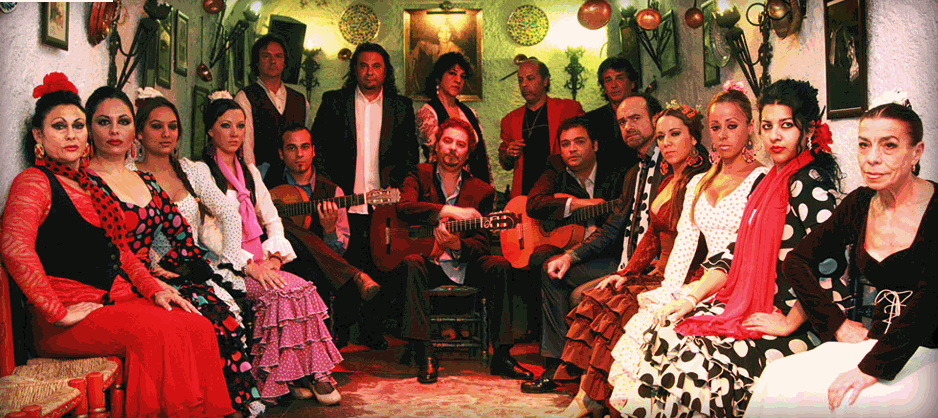
Granada is famous for its gitano Flamenco style
Flamenco flows liberally through the veins of Granada’s music scene, and can be traced back as far as the 1700s when gitanos – gypsies – first arrived on the scene. The musical culture in the city was already rich in flavour but the gitanos brought with them their own enchanting artform, which combined with Andaluz styles to create Flamenco as it is known today. It is the gypsies who have preserved Flamenco throughout the years. The barrio of Sacromonte is still home to many people of this origin and this is where the best, most authentic Flamenco – gitano style – in Granada takes place. However, Flamenco can be found all over the city, more predominantly in El Albaicin.
Bars & Tablaos
El Tabanco del Tio Gregorio (Flamenco on most Thursday and Friday nights)
Details: Cuesta de San Gregorio 24, Granada, Spain 18010; Tel. 662 13 70 46; (Facebook Page)
Eshavira (Flamenco on Thursday-Saturday nights)
Details: Calle Postigo de la Cuna, 2, Granada, Spain 18010; Tel. 958 29 08 29; (eshaviraclub.com)
Tablao Flamenco Jardines de Zoraya (Flamenco every night. Reservation necessary.)
Details: Calle Panaderos, 32; Tel: +34 958 20 62 66; (jardinesdezoraya.com)
Cuevas los Tarantos (Flamenco every night.)
Details: Camino del Sacromonte, 9; Tel: +34 958 22 45 25; (cuevaslostarantos.com)
Venta El Gallo Restaurant (Flamenco most nights.)
Details: Barranco de los Negros, 5; Tel: +34 958 22 84 76; (ventaelgallo.com)
El Templo del Flamenco (Flamenco every night.)
Details: Calle Pernaleros Alto, 41; Tel: +34 622 50 00 52; (templodelflamenco.com)
Cueva La Rocio (Flamenco most nights.)
Camino Sacromonte, 70; Tel: +34 958 22 71 29; (cuevalarocio.es)
Peñas
Peña La Platería (Flamenco every Thursday.)
Details: Placeta de Toqueros, 7; Tel: +34 958 21 06 50; (laplateria.org.es)
Sala Vimaambi (Flamenco Thursday-Saturday.)
Details: Cuesta de San Gregorio, 30 Granada; Tel: +34 958 22 73 34; (vimaambi.com)
Soniquete (Flamenco Fridays and Saturdays.)
Details: Carrera del Darro, 51; Tel: +34 639 69 20 41
There is no particular time of year when Flamenco is best in Granada. All through the year you can find high-quality shows being advertised around the busier areas of the city, in Plaza Nueva or along Carretera del Darro, for example. Entry fees are usually between 6-15 euros.
Málaga
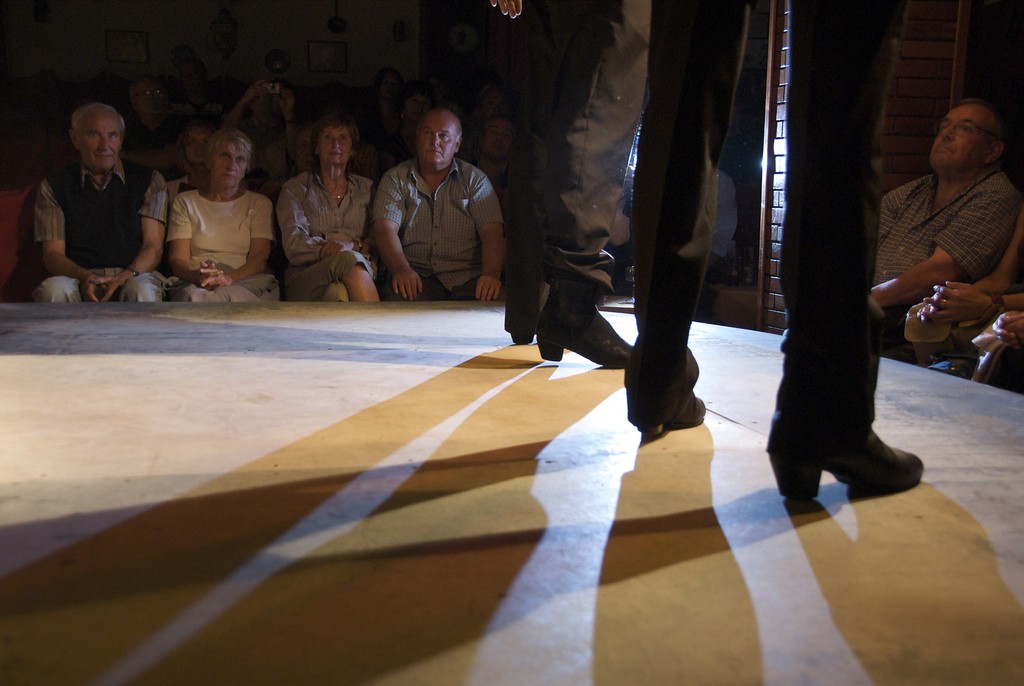
Flamenco Stage Cam (Source: FlickrCC fatifloresita)
While Malaga might be better known for its large amount of upscale places to eat, and trendy bars and clubs, there’s much in the way of authentic Flamenco, too. All around Malaga province there are peñas hidden away in small towns and villages. The best thing about them is that many of them do not want to be found, although if they are, then customers are always welcomed with open arms. The higlight of the Malaga Flamenco calendar is the Bienal de Arte Flamenco which comes to town at the end of the summer every year.
Bars & Tablaos
Bienal de Flamenco (Month-long festival held every September. Shows in participating bars.)
Details: (labienal.com)
Restaurant Tipi Tapa (Flamenco Tuesday, Thursday and Saturday nights.)
Details: Calle Málaga, 4, 29640 Fuengirola; Tel: +34 951 31 16 30; (restaurantetipitapa.com)
Kelipé Centro de Arte Flamenco (Flamenco Friday and Saturday from 9:15pm to 10:30pm. Reservations recommended.)
Details: Calle Caldereria, 6; Tel: 692 82 98 85; (kelipe.net)
Peñas
Peña Flamenca Fosforito
Details: Arenisca 12, Santa Cristina; Tel: 952 35 11 15
Peña Flamenca Juan Breva
Details: Calle Ramón Franquelo 4; Tel: 952 22 13 80
Elsewhere in Malaga Province
Flamenco in Andalucia is by no means limited to the big cities, though. The towns of Malaga Province alone are home to several great, authentic places to catch the real deal. Here are just a couple we can particularly recommend:
Peña Flamenca Niño de Vélez, Vélez-Málaga
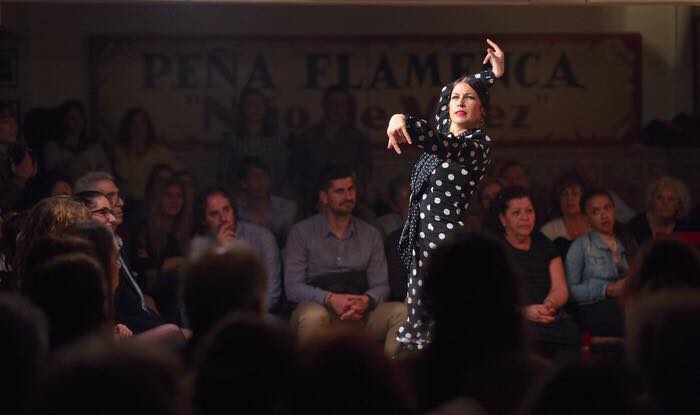
Flamenco Dancer – Vélez-Málaga
Vélez-Málaga isn’t the most conspicuously ‘luxe’ of towns. But what it lacks in airs and graces, it more than makes up for in a serious Flamenco scene. Spearheaded by the tireless Flamenco Abierto Axarquia, the town has undergone a Flamenco revolution in the past year or so and has seen great artists like Diego Carrasco & Family, Jorge Pardo, El Pele, José Valencia and Raquel ‘La Repompilla’ Heredia perform.
Details: Calle Tejeda, 10, Vélez-Málaga; Tel: 606 510 329; (Flamencoabierto.com)
El Burro Blanco, Nerja
Nerja’s long-standing tablao is, on the surface of it, a fun, lively place to have a drink and watch some tourist-friendly Flamenco. Don’t be fooled, though: on weekends, things get underway late and you can catch some of the best performers in the area strutting their stuff.
Details: 3 Calle de la Gloria, Nerja, 29780; Tel. 615 15 39 61; (Facebook Page)
As well as regular shows and peña performances, various espectáculos take place throughout Andalucia, especially over the summer months. These ‘spectacles’ can be more theatrical and friendly to the casual observer than ordinary shows. The Alhambra Palace in Granada, for instance, generally hosts events in the past, as has the otherworldly Cuevas de Nerja (Malaga) – a large, stalactite-laden, underground cavern with an installed Flamenco stage at its core. Now that’s pretty spectacular.
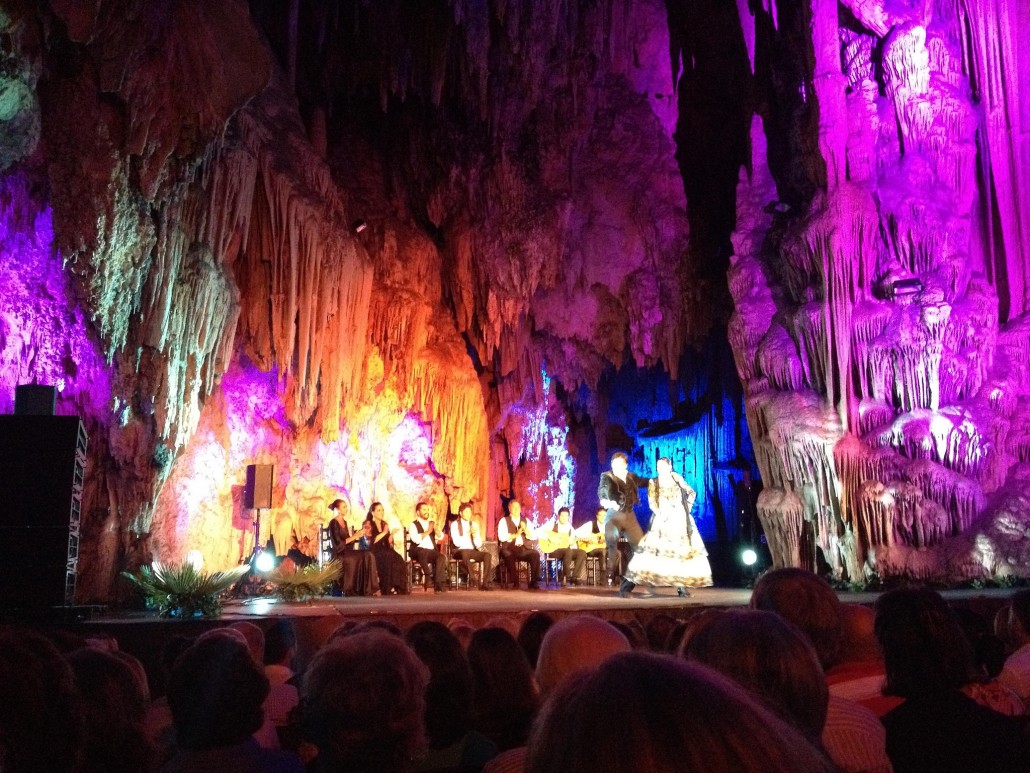
Cuevas de Nerja (Source: FlickrCC juanpol)
In southern Spain and looking to see some authentic Flamenco? Speak to our concierge and let them find – and book – you the very best.
You might also like





